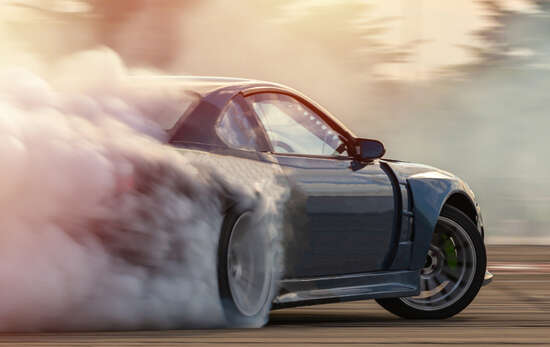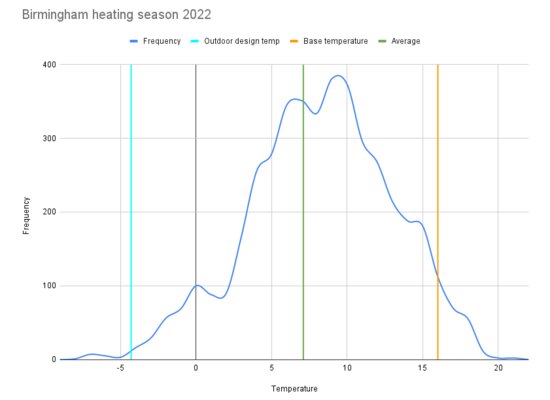Driving like mad

The way many of us have been running heating systems is like driving full throttle till the speed limit, then slamming on the breaks.
Not fuel-efficient, and certainly not comfy.
Sometimes driving like this can be fun if you know what you're doing. My friend is a drifter and deliberately drives very fast and with a heavy foot on the throttle. He loves it, but it costs a lot in fuel, and he takes 10 sets of spare tyres with him to every event!
And I'm not sure you'd want to choose to heat your house in the same way.

The graph above shows the spread of air temperatures in Birmingham in the heating season of 2022. The outdoor design temperature for Birmingham is -4.3ºC - so we'd pick a heating appliance big enough to keep the house warm when it's that cold outside.
In actual fact the house won't need heating until the outside temperature drops below the "base temperature", which I've notionally marked as 16ºC.
If the heating appliance is set up with a fixed flow temperature (not an uncommon situation), then when it's the average temperature of 7ºC outside, each room will potentially be getting over twice the amount of heat needed.
This is part of the reason TRVs or room stats where added in - to stop rooms overheating by turning off heat emitters. It takes time for the air at the level of the TRV to change temperature, and it takes time for the TRV itself to change temperature. This is the same, but in reverse, when the room cools down; there’s a time lag built in.
The result is room temperatures that go up and down, and a heating appliance that switches off and on more than it needs to = higher running costs, and more wear and tear.
Like repeatedly driving full throttle till the speed limit, then slamming on the breaks.
The different and better approach is also actually simpler - there are less parts needed. The appliance and heating system are set up so that just the right amount of heat is delivered to each room, with the appliance adjusting the temperature it supplies depending on how cold it is outside. This also means nice even room temperatures, that don't constantly yoyo.
In terms of the driving analogy this is paying better attention - adjusting how far you push the throttle depending on the conditions, the speed limit, and what's coming up ahead.
Which reduces fuel usage, and is a far more pleasant way to get from a > b.
You might squeeze an extra 10-20% efficiency out of a gas system like this, but gas is still relatively cheap. Electricity on the other hand is not so cheap and so where this really comes into it's own is with heat pumps.
Good system design might take a heat pump system from a seasonal efficiency of 280% to 400% - cutting running costs by around 30%!
We've been training and educating ourselves at Firepower, together with an initial group of the heating engineers that we supply, so that we can put this into practice, and improve on the systems we deliver together. To get started you can contact us, or fill out a heating report which will let us make insulation recommendations, and give an indication of the size of heating appliance you need for your home.
Ask a Question